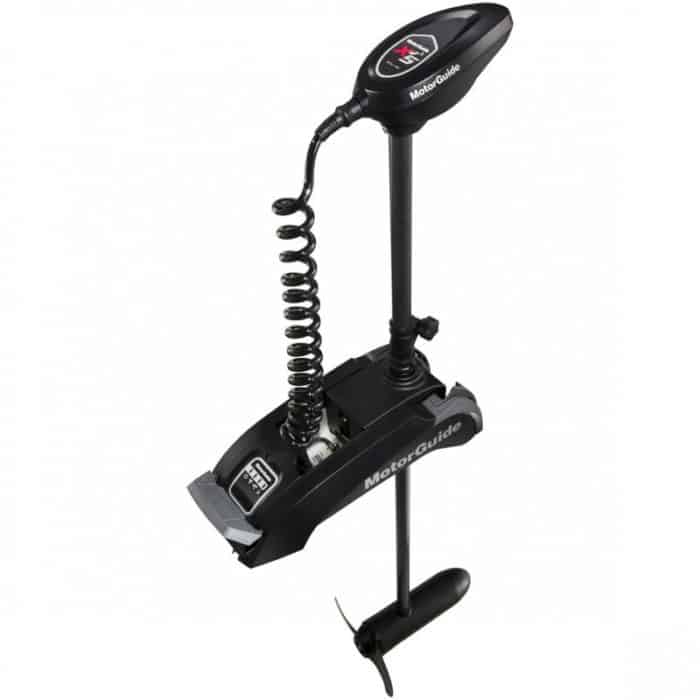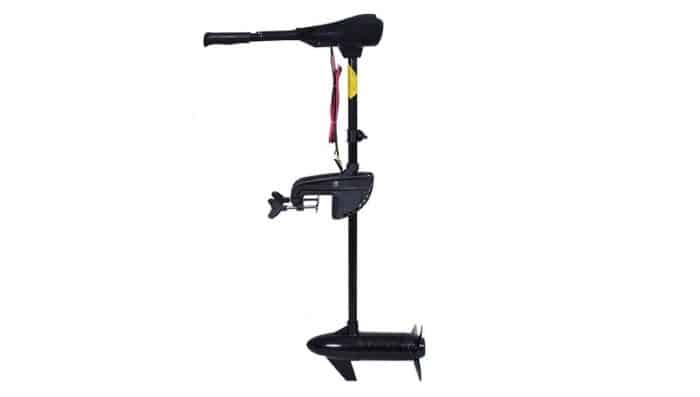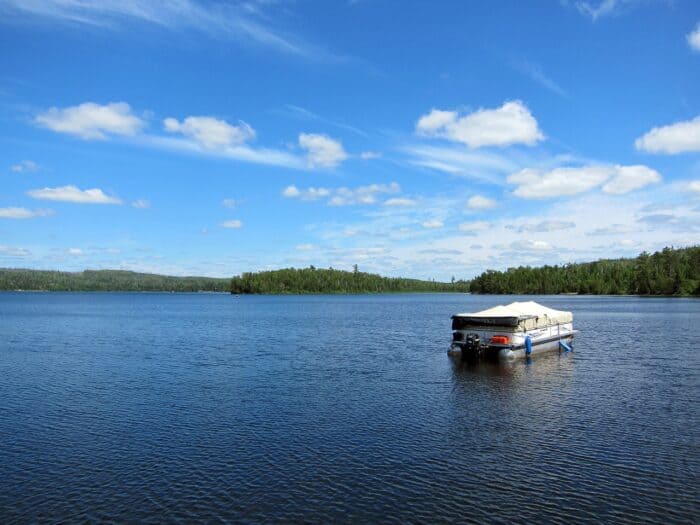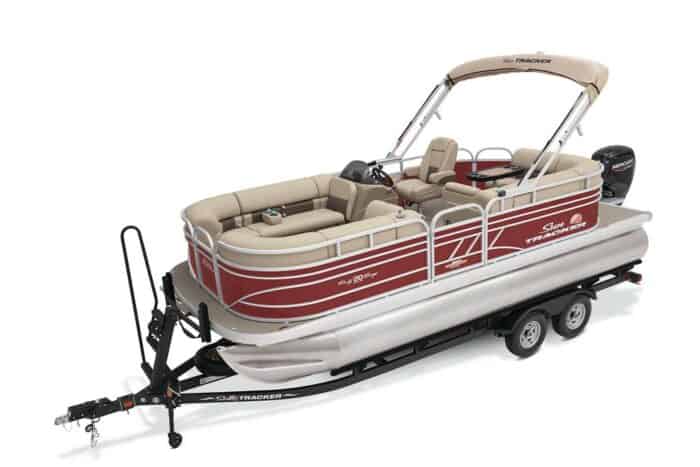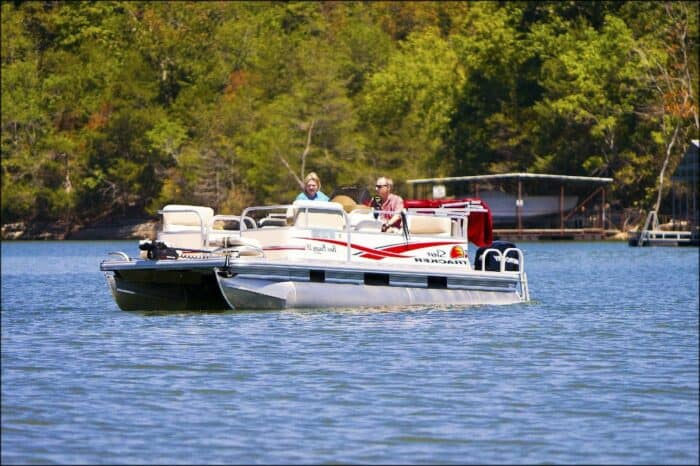How to Mount a Trolling Motor on a Pontoon Boat
Yes, you can mount a trolling motor on your pontoon boat to make it an even more effective fishing boat, but you’re going to want to choose a 24-volt, 80-lb thrust trolling motor. This is an important factor to keep in mind when you’re looking to do this for two reasons. One, many fishing barges are now being outfitted for trolling motors but the plugs they include are often only 12-volt. Also, those that come with full fishing kits including trolling motors will usually only include a 12-volt motor with maybe 55 lb of thrust. Unless you have a pretty small pontoon, this just isn’t good enough. You want about 5 lbs of thrust for every 400 lbs of boat, give or take.
Installing Trolling Motors on a Pontoon
The first thing we’d recommend before installing a trolling motor on a pontoon boat is to use a quick release bracket to do the job. Mounting a trolling motor directly to the deck is going to mean taking a lot of extra time every time you plan to trailer the boat, cover it, have family on the boat for things other than fishing and so on. It’s a hassle you don’t need which is exactly why quick release plates were invented.
There are a couple of types of quick release plates available so choose one that works with your pontoon design. Most pontoons that are designed for a trolling mount have a slot in the door to mount the motor. But some quick release plates have a bar that needs to be pulled to one side and the way it’s mounted on a pontoon means you can’t use them. Make sure you pick one that you can use with your set up.
Choose A Mounting Location
You can mount your trolling motor on the bow, on the transom or even on the main motor. This all depends on your preference and what works best with your pontoon. You’ll need to decide based on the style and layout of your boat what works best for you.
A Transom mount motor is usually smaller and easy to install. These are good choices for smaller pontoons as they basically just clamp on and are good to go. They’re relatively cheap too, but not powerful enough for larger boats and they lack some maneuverability. They can also interfere with your fish finder if you’re not careful.
Engine mount trolling motors are attached to the cavitation plate of your boat’s outboard engine. That makes them great space savers but they cost a lot more than a traditional trolling electric motor. They can also be trickier to operate and aren’t recommended for first timers to the boating world. You can install an engine mount trolling motor on boat an outboard an inboard outdrive motor.
Bow mount trolling motors are very common for pontoons. The fence at the bow of many pontoons is designed with a gap for a trolling motor to be mounted, as we mentioned above. They’re also easier to use and they offer great maneuverability so they’re a solid choice. They do take up a lot of space, but with a release plate you can easily take the motor off when you’re not using it so it should be worth the trade off.
Choose the Right Shaft Length
Pontoon boats sit higher than other boats which means you need to be careful when choosing the right shaft length for a trolling motor. For a bow mounted motor you would never want to go lower than a 48” shaft length. I’d recommend a 60” as a good length for a bow mount, since they should be a little longer as the bow tends to ride higher in the water.
Is a Bow Mounted Trolling Motor a Good Idea?
You can install a bow mount trolling motor but remember, you’ll need those special mounting brackets to do so. It’s definitely worth it so that you don’t need to remove and reinstall the trolling motor all the time.
Bow mounted trolling motors are, in my opinion, the best of your three options. Transom and engine mounted aren’t bad, but the bow mount offers the best performance you’re likely to get. At the front of your boat, the trolling motor is able to pull your boat forward instead of pushing it from the rear. That makes the process much smoother and easier for you to control.
Choose the Right Power Source
As I mentioned at the top, the power behind your pontoon trolling motor can be an issue. That so many boats are outfitted for 12 volts is not very helpful because that’s probably not going to be enough power for you. You’ll want to use the 24-volt at least and that means you’ll want a deep cycle battery to run it. Running a powerful trolling motor off of your boat’s battery is a bad idea because it’ll drain it incredibly fast. You need a dedicated trolling motor battery.
Deep cycle batteries can run for the long haul and if you have a good charger you can expect a lot of life out of your battery. They’re meant to be discharged below 50% over and over again which makes them ideal for trolling motors. A high quality lithium deep cycle battery can run through thousands of cycles over its lifespan providing you use it properly and is probably your best choice for running a trolling motor.
Just remember that a trolling motor eats up space and so too will your deep cycle batteries. They also can weigh quite a bit, with some up to 60 or 70 lbs. So you’ll want to make sure you have the capacity to handle them without going overboard.
The Bottom Line
Mounting a trolling motor on your pontoon is a great idea if you’re an avid angler, and it’s not all that hard to do. Make sure you choose the best mounting location for your particular style of boat. Also ensure your motor has the power to move your boat based on its weight – you should be going for a 24-volt, 80 lb thrust motor at least. Ensure the proper shaft length so that your trolling motor is at its most efficient. Make use of a quick release bracket so that you can remove and reinstall the motor quickly and easily without a lot of trouble. Finally, make sure you have room and capacity for a battery that can keep your motor powered and running.
Categories: Pontoon Boats
